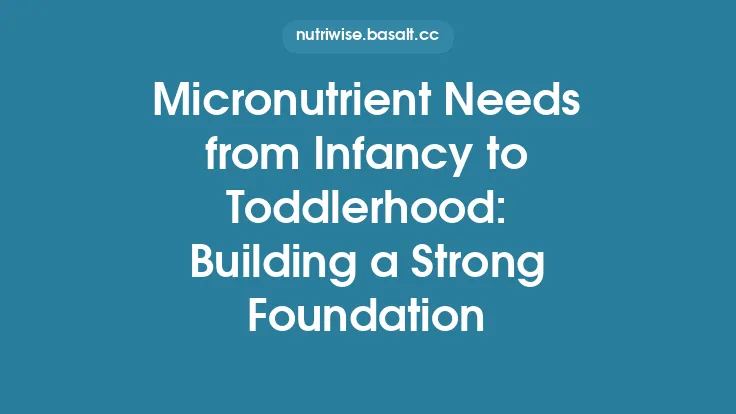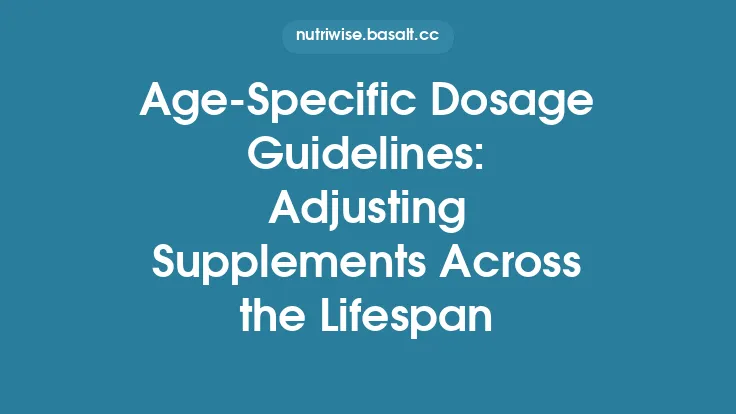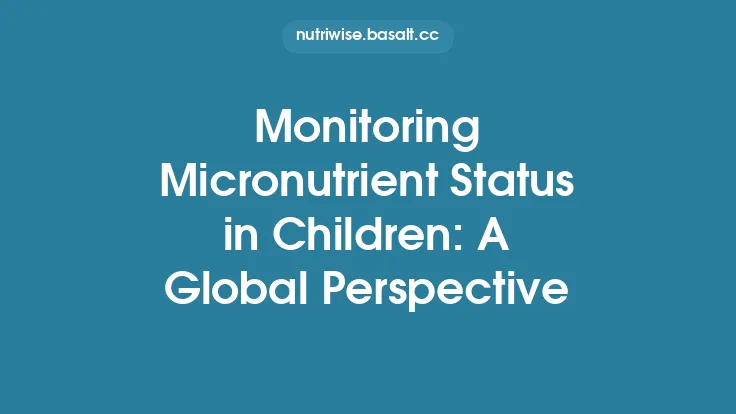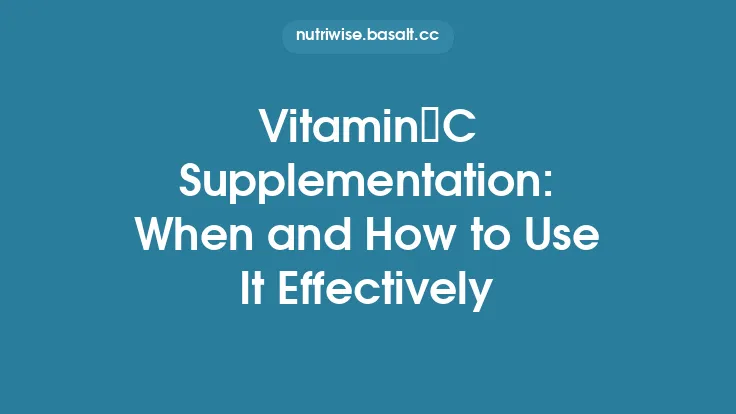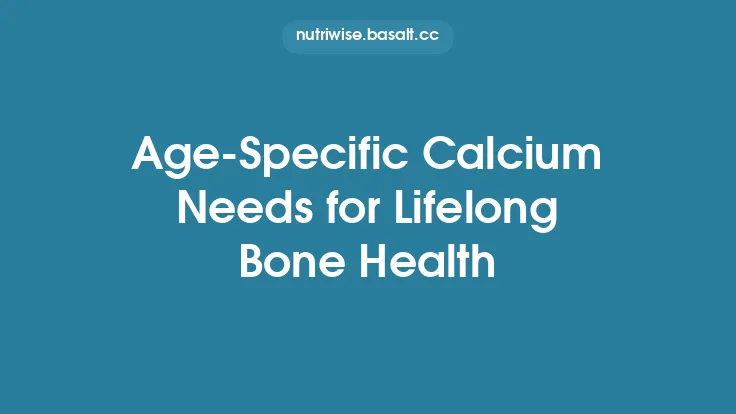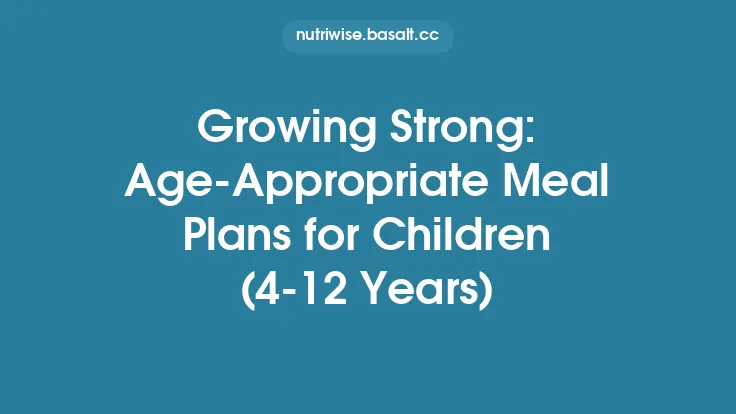Iron is an essential micronutrient that participates in oxygen transport, cellular respiration, DNA synthesis, and immune function. Because the body cannot synthesize iron, daily intake must match the amount lost through normal physiological processes and the amount required for growth and tissue renewal. These demands are not static; they shift dramatically from the rapid growth of early childhood to the altered metabolic landscape of older adulthood. Understanding how iron requirements evolve with age is crucial for preventing iron‑deficiency anemia, avoiding unnecessary supplementation, and supporting overall health across the lifespan.
Physiological Basis for Age‑Related Iron Requirements
The body’s iron economy is governed by three interrelated components:
- Supply – dietary intake and, in certain life stages, endogenous recycling of senescent red blood cells.
- Demand – the amount of iron needed for hemoglobin synthesis, myoglobin in muscle, mitochondrial enzymes, and proliferating cells.
- Regulation – primarily mediated by the hepatic peptide hepcidin, which controls the release of iron from macrophages and the entry of iron into the circulation via ferroportin.
During periods of rapid tissue expansion (infancy, puberty, pregnancy) the demand side of the equation rises sharply, prompting a physiological down‑regulation of hepcidin to permit greater iron flux into the bloodstream. Conversely, in later life, inflammatory tone often increases, hepcidin levels tend to rise, and the efficiency of iron recycling may decline, leading to a relative reduction in usable iron despite stable or even elevated total body stores.
Infancy and Early Childhood: Rapid Growth Demands
| Age Range | Recommended Dietary Allowance (RDA) | Typical Physiological Drivers |
|---|---|---|
| 0–6 months (breast‑fed) | 0.27 mg day⁻¹ (via breast milk) | Low iron content of milk; reliance on fetal iron stores |
| 0–6 months (formula‑fed) | 11 mg day⁻¹ | Iron‑fortified formula supplies higher amounts |
| 7–12 months | 11 mg day⁻¹ | Transition to solid foods; depletion of prenatal iron stores |
| 1–3 years | 7 mg day⁻¹ | Continued linear growth, brain development, expanding blood volume |
Key considerations
- Fetal iron stores: Full‑term infants are born with a finite iron reserve that typically sustains them for the first 4–6 months. Premature infants have markedly lower stores and may require supplemental iron earlier.
- Growth velocity: Between 6 months and 2 years, the rate of somatic growth peaks, demanding a proportional increase in hemoglobin mass and mitochondrial enzyme capacity.
- Dietary transition: Introduction of iron‑fortified cereals and pureed meats can help bridge the gap between declining stores and rising needs.
School‑Age Children: Balancing Growth and Activity
| Age Range | RDA (mg day⁻¹) | Primary Drivers |
|---|---|---|
| 4–8 years | 10 | Steady linear growth, expanding muscle mass |
| 9–13 years | 8 (girls) / 11 (boys) | Onset of puberty; divergent trajectories in hemoglobin mass |
Why the difference between sexes?
Girls typically experience earlier menarche, which introduces menstrual iron loss, whereas boys continue to accrue lean body mass without the added loss. Consequently, the RDA for boys in this window is modestly higher.
Practical note
At this stage, most children can meet their iron needs through a balanced diet that includes iron‑fortified grains and occasional animal‑source foods. Routine screening is not universally required but may be indicated for children with chronic gastrointestinal conditions or those on restrictive diets.
Adolescence: Puberty, Menstruation, and Increased Needs
| Age Range | RDA (mg day⁻¹) | Influencing Factors |
|---|---|---|
| 14–18 years (girls) | 15 | Menstrual blood loss (average 0.8–1 mg day⁻¹) |
| 14–18 years (boys) | 11 | Continued muscle accretion, increased blood volume |
Physiological shifts
- Menarche introduces a chronic, albeit modest, iron loss that can double the daily requirement for adolescent girls.
- Peak height velocity (typically 12–14 years for girls, 14–16 years for boys) coincides with a surge in erythropoiesis and mitochondrial biogenesis, raising iron demand.
- Hepcidin modulation: During the rapid growth phase, hepcidin is suppressed to facilitate iron mobilization; however, the onset of regular menstruation can counterbalance this suppression, necessitating higher dietary intake.
Clinical implication
Adolescent girls are the demographic most prone to iron‑deficiency anemia. Targeted education on dietary sources and, when appropriate, low‑dose iron supplementation (often 30–60 mg elemental iron per day) can prevent the development of deficiency without risking overload.
Reproductive‑Age Women: Menstrual Losses and Pregnancy Considerations
| Life Stage | RDA (mg day⁻¹) | Rationale |
|---|---|---|
| Non‑pregnant, non‑lactating (19–50 y) | 18 (women) | Average menstrual loss of ~1 mg day⁻¹ |
| Pregnancy (first trimester) | 27 | Expansion of maternal blood volume, fetal iron accretion begins |
| Pregnancy (second/third trimester) | 27 | Rapid fetal growth, placenta iron transfer |
| Lactation (first 6 months) | 9 | Iron transferred via breast milk is minimal; maternal stores are the primary source |
Key points
- Pregnancy: The fetus requires ~300 mg of iron by term, most of which is deposited in the third trimester. Maternal iron stores must be sufficient to meet this demand without compromising the mother’s own hemoglobin synthesis.
- Post‑partum: Iron needs drop sharply after delivery, but women who experience heavy postpartum bleeding may require temporary supplementation.
- Menopause: With the cessation of menstruation, the RDA for women aligns with that of men (8 mg day⁻¹), reflecting the removal of chronic blood loss as a driver.
Adult Men: Maintenance Phase
| Age Range | RDA (mg day⁻¹) | Primary Considerations |
|---|---|---|
| 19–50 years | 8 | Stable erythropoiesis, modest iron loss via skin desquamation and minor gastrointestinal bleeding |
| 51+ years | 8 | No major physiological changes in iron demand, but potential for age‑related gastrointestinal blood loss warrants periodic monitoring |
Adult men generally have sufficient iron stores to meet daily needs, provided they are not subject to chronic blood loss (e.g., peptic ulcer disease, frequent NSAID use). Routine supplementation is rarely indicated.
Older Adults and Seniors: Changes in Absorption, Storage, and Risk of Overload
| Age Range | RDA (mg day⁻¹) | Age‑Related Modifiers |
|---|---|---|
| 51–70 years | 8 (men) / 8 (women) | Slight decline in gastric acidity, modest reduction in intestinal iron absorption efficiency |
| >70 years | 8 (men) / 8 (women) | Increased prevalence of chronic inflammation (inflammaging) → higher hepcidin, reduced iron release from macrophages; higher risk of anemia of chronic disease |
Why the RDA does not increase
Even though absorption efficiency wanes, the overall physiological demand for iron does not rise dramatically after middle age. However, the balance between supply and demand becomes more fragile:
- Reduced gastric acid impairs the solubilization of dietary iron, especially non‑heme forms, leading to lower bioavailability.
- Inflammatory cytokines (e.g., IL‑6) stimulate hepcidin production, limiting iron egress from storage sites and contributing to functional iron deficiency.
- Comorbidities such as chronic kidney disease, heart failure, and malignancy can further disrupt iron homeostasis.
Clinical caution
Older adults are at risk both for iron deficiency (due to poor intake, malabsorption, or chronic blood loss) and for iron overload (particularly in individuals with hereditary hemochromatosis, which often manifests clinically after age 50). Regular assessment of ferritin, transferrin saturation, and complete blood count is essential before initiating any supplementation.
Assessing Iron Status Across the Lifespan
| Parameter | Interpretation | Age‑Specific Nuances |
|---|---|---|
| Serum Ferritin | Reflects stored iron; low <15 µg/L suggests depletion | In older adults, ferritin can be elevated by inflammation, masking true deficiency |
| Transferrin Saturation (TSAT) | Ratio of serum iron to total iron‑binding capacity; <20 % indicates low circulating iron | Useful in differentiating anemia of chronic disease (normal/high ferritin, low TSAT) from true deficiency |
| Hemoglobin (Hb) | Primary marker of anemia; age‑adjusted cut‑offs (e.g., <11 g/dL in toddlers, <12 g/dL in adolescent girls) | Hb alone cannot distinguish iron deficiency from other causes; must be paired with ferritin/TSAT |
| Soluble Transferrin Receptor (sTfR) | Increases when cellular iron demand rises; less affected by inflammation | Helpful in older adults where ferritin may be falsely high |
Screening recommendations
- Infants (6–12 months): Ferritin measurement if diet is low in iron or if growth falters.
- Adolescents (especially girls): Annual hemoglobin check; ferritin if Hb is borderline.
- Pregnant women: First‑trimester ferritin and Hb; repeat in the third trimester.
- Adults >65 years: Full iron panel every 2–3 years, or sooner if chronic disease is present.
Guidelines for Safe Supplementation and Monitoring
- Confirm deficiency before supplementing – Use a combination of ferritin, TSAT, and Hb to avoid unnecessary iron exposure.
- Select appropriate dose – For mild deficiency, 30–60 mg elemental iron daily is usually sufficient; higher doses increase gastrointestinal side effects without improving absorption.
- Duration – Continue supplementation for at least 3 months after normalization of laboratory values to replenish stores.
- Re‑evaluation – Repeat iron studies 4–6 weeks after initiating therapy; adjust dose or discontinue if ferritin exceeds 100 µg/L in the absence of ongoing loss.
- Special populations –
- Pregnant women: Prefer prenatal formulations that include folic acid and vitamin B12, with iron doses tailored to individual ferritin levels.
- Older adults: Start with the lowest effective dose; monitor for signs of overload, especially in those with known HFE gene mutations.
Practical Recommendations for Caregivers and Health Professionals
- Educate families about the critical windows of iron demand (infancy, puberty, pregnancy) and the importance of age‑appropriate dietary patterns.
- Encourage routine health checks that include iron status, particularly for groups at higher risk (adolescent girls, pregnant women, seniors with chronic disease).
- Adopt a “first‑do‑no‑harm” approach: before prescribing iron, rule out alternative causes of anemia (e.g., vitamin B12 deficiency, chronic kidney disease) and assess for potential contraindications such as hemochromatosis.
- Document baseline labs and maintain a clear follow‑up schedule to track response to therapy and prevent inadvertent iron overload.
- Collaborate with dietitians when dietary modifications are needed, ensuring that recommendations are culturally appropriate and feasible for the individual’s life stage.
By aligning iron intake with the physiological realities of each life stage, clinicians, caregivers, and individuals can safeguard against both deficiency and excess. This age‑specific framework provides a durable, evidence‑based roadmap for maintaining optimal iron status from the earliest days of life through the senior years.
